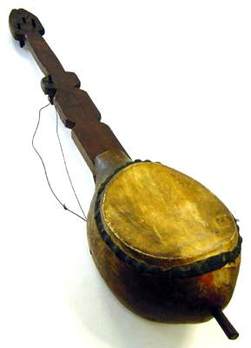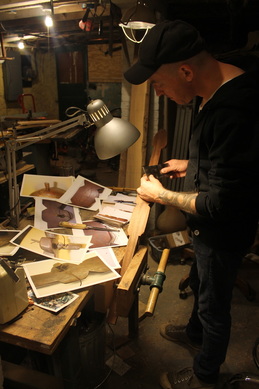REPLICA of the instrument at the Musee de la Musique, Paris
The original Haiti Banza |
In 2003, an early banjo finally turned up which was clearly akin to some of the earliest banjos made in North America by enslaved African American. The instrument was collected in 1840, by an abolitionist in Haiti and had gone unnoticed in the collection of the Musee de la Musique, Paris for 160 years.
The Haitian Banza was rediscovered when Saskia Willeart, of the Musical Instrument Museum, Brussels, was searching for material for her museum's Banjo! exhibit. As soon as word of the Banza got to across the Atlantic, Pete made plans to travel to Europe to see it. Pete measured and photographed the Banza inside and out. You can read more about the discovery and the significance of the Banza in essays by Saskia and Pete in the book Banjo Roots and Branches (UIP, 2018). The Haitian Banza is so important that Pete has faithfully reproduced it, down to the finest measurements and copied every stray tool mark, as well as every stain or scratch on the instrument. Even these seemingly accidental marks could add something significant to the still scarce evidence about the earliest banjos of the Americas. The reproductions Pete has made thus far are all in a "just before collected" state. Pete has used his knowledge as a luthier to recreate the missing bridge and nut. He has not reproduced the cracks in the now-damaged gourd and left off the original collectors notes, which were written on the instruments head. |
Haitian Banza Base Price: $1,200
I only work on custom orders and my waitlist is currently closed. If you are a musician or museum with an exhibit or performance date you have to meet, please contact me. I'm happy to talk banjo if you have any special commission ideas you’d like to talk about as well. You can also get on my email list to stay updated on when I will be opening my list again and for any builder's choice banjos that may become available.
|
"One of the most interesting things about the Haitian Banza is the close resemblance to the banjos illustrated by Sloan as well as the banjo in the "The Old Plantation" painting. They are clearly all part of the same New World gourd banjo tradition. Especially pleasing to me is the fact that my interpretation of those images, which I'd been making for years before the discovery of the Haitian Banza, are so similar to the instrument.
In a sense, a hypothesis suggested by my reproductions is now proven. The resemblance is so close in fact, that while the Haitian Banza was sitting next to one of my reconstructions of the Old Plantation banjo in Brussels Musical Instrument Museum, Mia Awouters, the museums director said to me, 'What you've done here, is remarkable.'" - Pete Ross |


